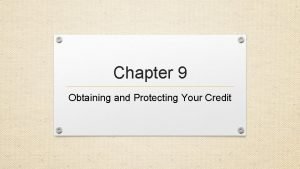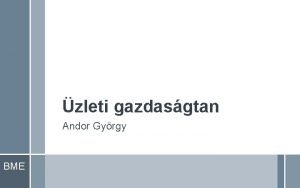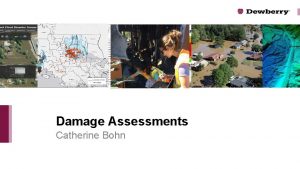Protecting your most important asset against damage andor







- Slides: 7

Protecting your most important asset against damage and/or loss requires INSURANCE Presented by Raymond Hayes, Personal Lines Agent Esser Hayes Insurance Group

Working with Contractor / Sub-Contractors Securing coverages • Whenever a contactor or subcontractor steps onto your property to work on your house, you face the risk that someone may get injured and hold you liable. • Make sure your contractor has adequate insurance coverage before work begins. The contractor should provide proof of insurance, in the form of a “certificate of coverage, ” for workers compensation and contractor’s liability insurance. Contractor’s General Liability – covers the contractor for damage to your property while it’s under construction. • Example: If there’s a big hole in an outside wall and the contractor fails to cover it properly during a rainstorm, water could leak in and cause major damage. Though homeowners insurance will cover these damages, your insurer will expect the contractor’s insurance company to pick up the tab if you make such a claim. Workers Compensation – covers injuries to the contractor and his employees while they’re working. If a worker is injured in your home and the contractor does not carry workers compensation, you could be sued.

Contractor / Sub-Contractor coverages Builders Risk – If there is a individual or company with a financial interest in a construction project they will want the project to be covered by a Builder’s Risk policy. • If a project is being financed by a bank or other lender, Builder’s Risk insurance will usually be a prerequisite for the financing. The construction contract normally specifics all interested parties must be named as insured under the policy. • The named insureds on a policy might include: owner/developer, mortgagee or lenders, the general contractor, and sub-contractors. • New construction – GC will often purchase the Builder’s Risk policy because it will likely have complete control of the project property during construction. • Renovations – Home owner usually purchases the Builder’s Risk policy assuming the contactor is only working on a portion of the total property during the project.

HOMEOWNERS INSURANCE - Specialty Coverages Can you imagine if you woke up to 3 – 4 feet of water and sewer backed up into your basement? Who would you call? Where would you stay? What if the water damaged the furnace and the temperature outside was below zero? Water & Sewer Back-up – Most homeowner’s policies do not automatically include this coverage for this type of loss. Adding this endorsement provides coverage for the damage to the home and personal property, as well as the cost for a restoration company to clean up the damage including mold or mildew. • Many policies even pay for a stay in a hotel or other housing while your home is being repaired. Water & Sewer back-up is one of the most common homeowner’s claims.

HOMEOWNERS INSURANCE - Specialty Coverages Replacement Cost insurance – covers the cost of replacing your home, and those contents covered under the policy, if they are severely damaged or destroyed. Your insurance policy would pay what it would cost to go out to a store and purchase the items today. • Actual Cash Value is usually standard and you may elect to purchase Replacement Cost Coverage. All Risk vs. Named Peril A named peril insurance policy covers only what is specifically noted in the policy. For example- if it doesn’t say you’re covered for vandalism damages or backed up sewers, you aren’t. Named Peril policies are usually less expensive than an All-Risk policy. • When coverage is written on a named peril basis, the burden is on the insured to prove that one of the named perils caused the loss. An All-Risk policy covers everything except what is specifically excluded in the policy. The All-Risk policy may be more expensive but it is more comprehensive. • Under an All-Risk policy, the burden is on the insurance company to prove the peril causing the damage is not excluded; otherwise coverage applies.

HOMEOWNERS INSURANCE - Specialty Coverages Ordinance and Law – If a disaster damages or destroys your home, the renovations and reconstruction must meet current building codes and regulations. Older homes likely do not meet these standards, meaning their owners can face hefty bills to upgrade. Your basic homeowners policy exists to restore the home to the condition it was in before the calamity. If the policy covered losses and extra costs caused by regulations that didn’t exist when your home was built, you would get a windfall by having a better home than before the peril happened. The insurer would be concerned that you would have an incentive for a loss. Thus, you need law and ordinance coverage to pay for the current costs of bringing a damaged building to current codes and laws.

RE-EVALUATE YOUR COVERAGE WHEN CONSTRUCTION IS COMPLETE Once the building is complete, re-evaluate your homeowners insurance coverage. If you have a standard homeowners insurance policy, make sure that you have purchased the right amount, especially if you have made alterations to the original building plan. One in four remodeling projects increases the value of a home by more than 25 percent.













